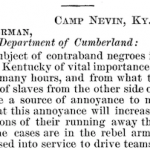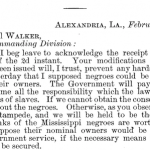Search Summary
- Search conducted by Cooper Wingert between March 29-April 4, 2019.
- Keywords: “slave stampede,” “stampede of slaves,” “stampede of negroes.”
- Totals: 11 hits
Top Results
- In December 1863, Col. James McFerran of the 1st Missouri State Militia Cavalry reported a “small stampede of negroes from the vicinity of Lexington, [Missouri] carrying away two horses, which have not been recovered at last accounts.” (The War of the Rebellion: A Compilation of the Official Records of the Union and Confederate Armies, (Washington: Government Printing Office, 1881-1901), Series 1, vol. 22, pt. 2, 746; hereinafter cited as OR)
- Recounting the December 1858 escape of some 11 slaves from western Missouri, with the aid of abolitionist John Brown, an 1863 book described “the panic which followed this invasion.” Fearing “a general stampede of slaves,” it noted, “the two counties of Bates and Vernon were soon quite cleared of their ‘chattels,’ which were sent into the interior or shipped to the South for sale.” (Orville J. Victor, History of American Conspiracies; A Record of treason, rebellion, &.c. in the United States of America, from 1760 to 1860, (New York: J.D. Torrey, 1863), 516)
- The term “slave stampede” was also used by New York Sen. William H. Seward in May 1860, during his testimony before a Senate committee investigating the Harpers Ferry insurrection. He reported that Hugh Forbes, a one-time associate of John Brown, had “suggested the getting up of a stampede of slaves secretly on the borders of Kansas, in Missouri, which Brown disapproved.” (Report of the Select Committee of the Senate Appointed to Inquire into the Late Invasion and Seizure of the Public Property at Harper’s Ferry, (Washington: n.p., 1860), 254)
- In 1853, the American & Foreign Anti-Slavery Society reprinted two advertisements using the term “stampede” to illustrate the increasing number of escaping slaves. A “negro stampede” from Kentucky, reportedly inspired by Uncle Tom’s Cabin, had seen “twenty-five negroes” escape from Boone County, Kentucky. (The Thirtieth Annual Report of the American & Foreign Anti-Slavery Society, Presented at New-York, May 11, 1853, (New York: Lewis J. Bates, 1853), 144)
- Writing to Brig. Gen. William Tecumseh Sherman in November 1861, Brig. Gen. Alexander McCook at Camp Nevin, Kentucky, reported that ten “contraband negroes” had made their way behind his lines, while also informing him that “there will be a general stampede of slaves from the other side of Green River.” (OR Series 1, vol. 4, 337).
- In 1861, the periodical The Living Age reprinted a speech by Edward Everett, in which the noted orator predicted that should secession be allowed to stand undisputed, conflict would still arise. “A general stampede of slaves shall take place along the Border,” Everett asserted, “with no thought of rendition,” sparking a “Border-war” spanning “a frontier of fifteen hundred miles.” (The Living Age, vol. 70 (August 1861), 283)
- An 1863 book castigating the South and secession reprinted an 1862 article from the Christian Banner, entitled “Stampede of Slaves.” The article described “thousands of negroes in Virginia” who were “taking leave of their owners.” The book also reprinted another article from the same newspaper, referring to “the stampede of negroes” from Virginia which “continues with increased numbers.” (James W. Hunnicutt, The Conspiracy Unveiled: the South Sacrificed, or The Horrors of Secession, (Philadelphia: J.B. Lippincott, 1863), 369, 445-446)
- Confederates also used the term “stampede” in their dispatches. Writing from Alexandria, Louisiana in early February 1864, Maj. Gen. Richard Taylor discussed hiring (or renting) slaves from their owners to serve as laborers for Confederate forces in the region. However, Taylor was determined to “obtain the consent of owners,” otherwise he predicted, “there will be a general stampede, and we will be held to be the cause of it.” (OR Series 1, vol. 34, pt. 2, 939)
- The novelist Harriet Beecher Stowe used the term “stampede of negroes” in her 1873 publication, Palmetto-Leaves. (Harriet Beecher Stowe, Palmetto-Leaves, (Boston: J.R. Osgood and Company, 1873), 271)
- The term “slave stampede” also appeared in an 1894 book by abolitionist Richard Hinton. Recalling a conversation with John Henry Kagi prior to John Brown’s slave insurrection at Harpers Ferry, Hinton noted that the first stage of the plan was intended to appear as “a slave stampede, or local outbreak at most.” (Richard J. Hinton, John Brown and His Men: With Some Account of the Roads they traveled to reach Harper’s Ferry, (New York: Funk & Wagnalls, 1894), 673)
Select Images
- OR Series 1, vol. 4, 337
- Hunnicutt, The Conspiracy Unveiled, 445.
- OR Series 1, vol. 34, pt. 2, 939
General Notes




